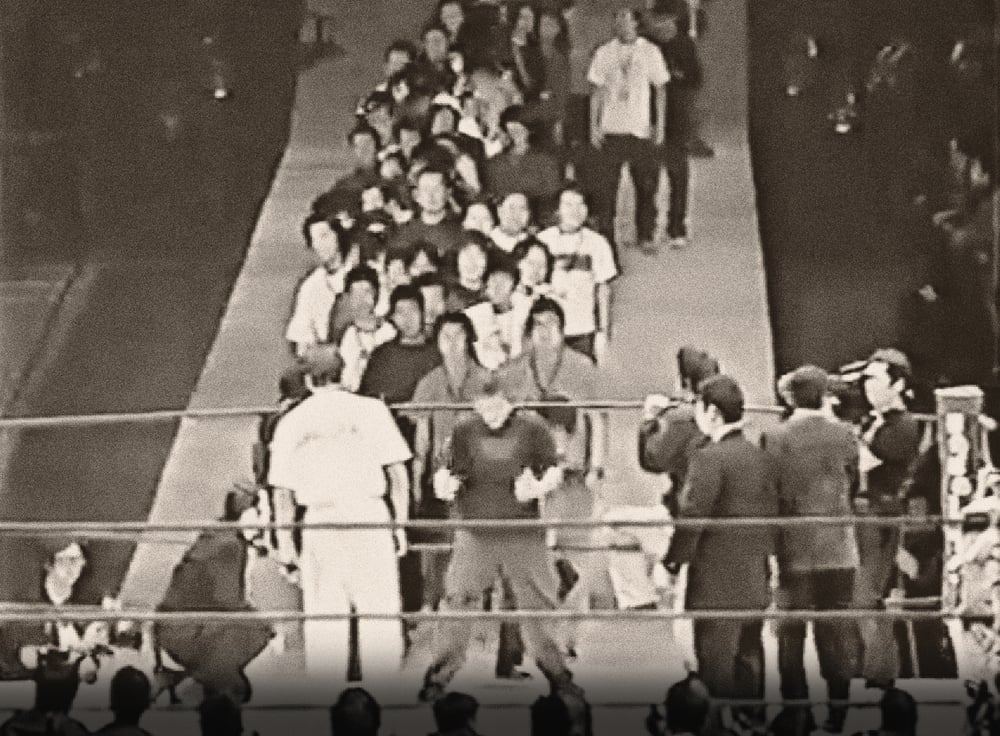
Issue 083
December 2011
Antonio Inoki Slaps Lyoto Machida
Why exactly did future UFC light heavyweight champion Lyoto Machida receive public face slaps from Japanese pro wrestling patriarch Antonio Inoki? FO acts as your cross-cultural translator
Lyoto Machida made his MMA debut at Ultimate Crush on May 2nd 2003 at the Tokyo Dome. The event was a hybrid; featuring five vale tudo bouts and five pro wrestling bouts. But the Brazilian’s fight is remembered most for what took place outside of the ring.
Machida’s name triggers a host of clear images in the minds of fans: the understated ring walks, the gi and black belt paying respect to his karate roots and, of course, the light-footed southpaw style that bamboozled the world’s best. His first time out bears no resemblance to his later contests. He strolls to battle wearing a grass skirt, a blue headdress and shakes a pair of decorated maracas in time to his drum-heavy intro. During the fight, there is none of ‘The Dragon’s trademark in-and-out elusiveness. Instead, he constantly looks for the takedown, then dominates Kengo Watanabe on the canvas to claim a unanimous decision victory. From beginning to end, he looks every inch the pro wrestler.
Throughout the fight, Japanese wrestling legend and proto MMA fighter Antonio Inoki has been watching intently from ringside: an imposing figure with his jutting chin and immaculate grey suit. As Lyoto leaves the ring, he goes to meet Inoki. The veteran wrestler gets to his feet, squares up and slaps Machida across the face with his right hand, then his left before punching him on the chin. Machida takes the heavy blows, then bows. Inoki shakes his hand then departs.
This bizarre incident has generated plenty of speculation over the years – mainly from bemused Westerners. The truth resides somewhere between the mythology of traditional Japanese arts and the crazy showmanship of pro wrestling.
Antonio Inoki is a true giant of the fight scene: an innovative wrestler, a pioneering promoter and part of Japanese pop culture. Outside of Japan, he is best known for his ‘style versus style’ fight with Muhammad Ali in 1976. Inoki spent 15 rounds on his back as ‘The Greatest’ stood off him and the much-hyped clash degenerated into a tedious non-event.

The story of Lyoto Machida as a karate prodigy from a family of shotokan masters has regularly been retold. His association with Inoki is lesser known. When Lyoto was in his teens and developing into an all-round martial artist, Inoki taught the youngster how to grapple. As their relationship developed, the old hand was well placed to advise on how to progress in the cut-throat world of prizefighting.
The Inoki slap was born in the ’80s. On a visit to a school, Inoki agreed to take punches from two students in a jovial stunt. The first assailant to come to the front of the classroom barely reaches Antonio with his feeble effort. The
second lad was bolder, snapping a far more convincing right hand to the stomach. Quick as a flash, Inoki slaps him across the face, with a smack that resonates around the room. The kid then bows politely.
The clip was regularly featured on Japanese TV. Knowing the value of a gimmick, Inoki named it the Toukon (Fighting Spirit) slap and would recreate it on game shows. A mystique grew around the symbolic strike, with people embellishing the story of its origins with talk of the mystical power of the blow.
Before long, it was common for members of the public to approach Inoki and ask him to slap them, hoping that being on the receiving end would bless them with courage and the heart of a fighter. On New Year’s Eve 2000 at the Inoki Bom-Ba-Ye 2000 show, literally hundreds of people queued up on the runway at the Osaka Dome – all of them waiting for their turn to get in the ring and get a smack across the chops from the great man.

Going into the Watanabe match, Lyoto had been described as an Inoki disciple. By forcefully slapping the newcomer, the old stager was publicly endorsing him. It is unlikely the slap had any actual magical powers, but the public backing of a superstar like Inoki was worth more in marketing terms than a truckload of fairy dust. Machida went on an unbeaten run, including a devastating TKO of Rich Franklin at Inoki Bom-Ba-Ye ‘03.
Despite the patronage of Inoki, Machida never really caught the public imagination in Japan. He only became a true star when he joined the UFC. Initially, his solid, safety-first approach and tendency to go the distance did not win approval from the masses. All that changed with his spectacular KO wins over Thiago Silva and Rashad Evans; the latter earning him the 205lb title.
Pundits predicted a long reign and the Machida era was declared. But the bubble burst as quickly as it inflated when ‘Shogun’ Rua ripped the belt from him in brutal fashion, before ‘Rampage’ Jackson outpointed him to further downgrade his stock.
Lyoto rebounded by going back to basics. At UFC 129, he was matched against Randy Couture. After 65 seconds of the second, the Brazilian scored a stunning KO by way of jumping front kick: basically the flying crane kick from the Karate Kid movie. Like he did after his first fight, Machida paid tribute to a Mr Miyagi-type figure who had helped him to victory. Eight years before, he took a ceremonial slap from Inoki. This time, he used his post-fight interview to honor the man who had taught him the fight-ending move: B-list action movie star turned South American martial arts guru Steven Seagal.










